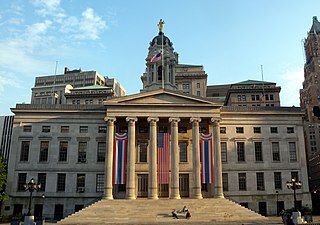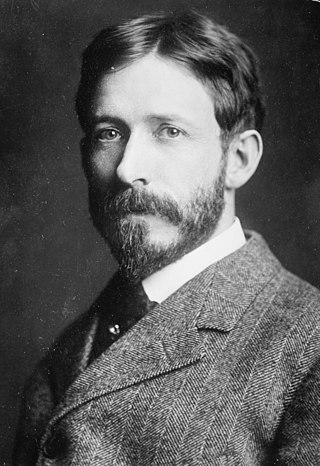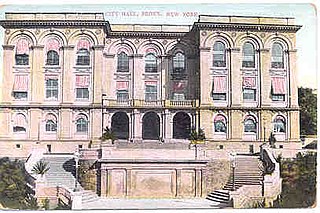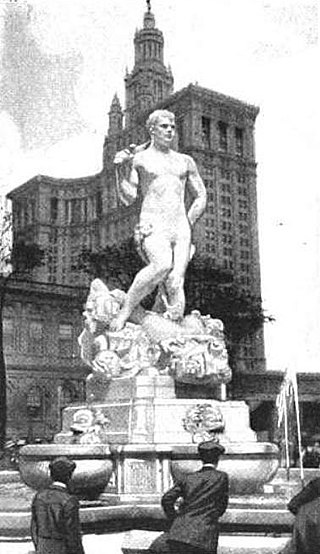See also
| By topic | |
|---|---|
| Boroughs |
|
| Government | |
| Emergency services | |
| Transportation | |
| Culture | |
| Education | |
| History | |
| Topics | ||
|---|---|---|
| Lists by county |
| |
| Lists by city | ||
| Other lists | ||
This is a list of New York City borough halls and municipal buildings used for civic agencies. Each of the borough halls serve as offices for their respective borough presidents and borough boards.

Downtown Brooklyn is the third largest central business district in New York City, and is located in the northwestern section of the borough of Brooklyn. The neighborhood is known for its office and residential buildings, such as the Williamsburgh Savings Bank Tower and the MetroTech Center office complex.
The borough president is an elected office in each of the five Boroughs of New York City. For most of the city's history, the office exercised significant executive powers within each borough, and the five borough presidents also sat on the New York City Board of Estimate. Since 1990, the borough presidents have been stripped of a majority of their powers in the government of New York City.

The David N. Dinkins Municipal Building is a 40-story, 580-foot (180 m) building at 1 Centre Street, east of Chambers Street, in the Civic Center neighborhood of Manhattan in New York City. The structure was built to accommodate increased governmental space demands after the 1898 consolidation of the city's five boroughs. Construction began in 1909 and continued through 1914 at a total cost of $12 million.

The flags of New York City include the flag of New York City, the respective flags of the boroughs of The Bronx, Brooklyn, Manhattan, Queens, and Staten Island, and flags of certain city departments. The city flag is a vertical tricolor in blue, white, and orange and charged in the center bar with the seal of New York City in blue. The tricolor design is derived from the flag of the Dutch Monarchy—the Prince's Flag—as used in New Amsterdam in 1625.

The Boroughs of New York City are the five major governmental districts that compose New York City. The boroughs are the Bronx, Brooklyn, Manhattan, Queens, and Staten Island. Each borough is coextensive with a respective county of the State of New York: The Bronx is Bronx County, Brooklyn is Kings County, Manhattan is New York County, Queens is Queens County, and Staten Island is Richmond County.

Brooklyn Borough Hall is a building in Downtown Brooklyn, New York City. It was designed by architects Calvin Pollard and Gamaliel King in the Greek Revival style, and constructed of Tuckahoe marble under the supervision of superintendent Stephen Haynes.

The 1917 New York City mayoral election replaced sitting mayor John P. Mitchel, a reform Democrat running on the Fusion Party ticket, with John F. Hylan, the regular Democrat supported by Tammany Hall and William Randolph Hearst.

Queens Borough Hall is a public building in the Kew Gardens neighborhood of the Queens borough of New York City which houses the Office of the Queens Borough President and other city offices and court space. It is located in the Kew Gardens municipal facilities stretch bounded by Queens Boulevard and Union Turnpike among other roads.

The Bronx Borough Courthouse, commonly referred to as the Old Bronx Borough Courthouse, is a building in the Melrose neighborhood of the Bronx, New York City. The courthouse was built between 1905 and 1914 near Boston Road, Third Avenue, St. Anns Avenue, and 161st Street. The 161st Street station of the New York City Subway's IRT Third Avenue elevated was in front of the courthouse. For two decades it housed the Supreme, Surrogate's, and County Courts of the borough until the larger Bronx County Courthouse was built in 1934. The Bronx Branch of the New York City Criminal Court remained here until 1977 when the city formally sealed the doors. It is a National Register of Historic Places listing and a New York City Landmark.

George McAneny, was an American newspaperman, municipal reformer and advocate of preservation and city planning from New York City. He served as Manhattan Borough President from 1910 to 1913, President of the New York City Board of Aldermen from 1914 to 1916, and New York City Comptroller in 1933. He also held several other positions throughout his career, serving as an executive officer of the New York City Civil Service Commission in 1902, secretary of the New York Civil Service Reform League (1894-1902), executive manager of The New York Times (1916-1921), and president of the Regional Plan Association (1930-1940).

Michael John Garvin, also known as Michael J. Garvin and M. J. Garvin (1861–1918), was an American architect from The Bronx, New York. A graduate of Manhattan College, he served as the first Building Commissioner of the borough (1897–1903) and its first Under Sheriff. With the placement of the influential IRT Third Avenue Elevated train, Garvin was immersed in designing many surrounding structures during the borough's increasing growth at the turn of the 20th century. Of his architectural contributions the Haffen Building; the Fire House, Hook and Ladder 17; and the Bronx Borough Courthouse have all become New York City landmarks while the latter a US National Historic Place.

The 2013 elections for borough presidents were held on November 5, 2013, and coincided with elections for Mayor, Public Advocate, Comptroller, and members of the New York City Council. Primary elections were held on September 10, 2013.

The Bronx Municipal Building, later known as Bronx Borough Hall and eventually as Old Bronx Borough Hall (1897–1969), was the original administrative headquarters of the Bronx Borough President and other local civic leaders. It was located in the East Tremont neighborhood of the Bronx, New York City.

Civic Virtue Triumphant Over Unrighteousness (1909–1922) is a sculpture group and fountain in New York City, created by sculptor Frederick William MacMonnies and architect Thomas Hastings, and carved by the Piccirilli Brothers. The fountain was originally placed in front of New York City Hall in Manhattan, spent almost 72 years beside Queens Borough Hall in Queens, and the sculpture group is now located in Green-Wood Cemetery in Brooklyn.
The City Club of New York is a New York City–based independent, not-for-profit organization.

An election was held to fill the Municipal Assembly of the newly-created City of Greater New York on November 2, 1897. The charter of the new city had created a bicameral Municipal Assembly, consisting of an upper Council and a lower Board of Aldermen. Each chamber was elected from specially-made districts. In addition, the president of the Council was elected in a separate election on the same day.

The Justice Ruth Bader Ginsburg Municipal Building, also the Brooklyn Municipal Building, is a civic building at 210 Joralemon Street in the Downtown Brooklyn neighborhood of New York City, built in 1924. Designed by McKenzie, Voorhees & Gmelin, it cost $5,800,000. It contains a branch of the New York City Clerk's office and branch offices for the Departments of Buildings, Probation, Finance, and Environmental Protection.